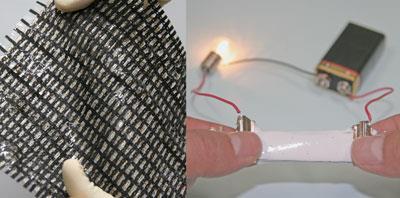Nanotube-packed polymer could be used for cheap flexible displays and robot 'skin'
Japanese scientists have printed organic transistors onto elastic conducting materials to create stretchy electronic sheets. They say the same technique could be used to reduce the cost of materials in flexible displays, as well as to produce artificial skin for robots and intelligent surfaces that allow humans and machines to interact.
Led by Takao Someya, a team at the University of Tokyo embedded carbon nanotubes in a polymer matrix to produce the world’s first highly conductive, chemically stable elastomer. ’Carbon nanotubes are sometimes used to increase a material’s stiffness. This is quite the opposite direction and a unique feature of our material,’ says Someya.

The stretchy material is fabricated from ’bucky gel’, a black paste made by grinding nanotubes with an ionic liquid - 1-butyl-3-methylimidazolium bis(trifluoromethanesulfonyl)imide. The grinding process prevents the nanotubes sticking together in large bundles, helping to reduce stiffness.
After combining with a fluorinated copolymer, which gives the material its elasticity, the gel is poured and dried. The resulting film is then coated with silicone rubber to form an elastic conductor. It can be punched with holes, increasing its elasticity even further, or stamped with organic transistors to make an electronically active sheet that can withstand being stretched by up to 70 per cent without any impact on its electronic performance.
The researchers used a small-scale printer to make a 20 by 20cm prototype that demonstrates the feasibility and cost effectiveness of their approach. Someya thinks the process could easily be scaled up in industry. ’I don’t see any problems in manufacturing much larger integrated circuits using these elastic conductors,’ he says.
However, Someya’s team are hoping to achieve more than just cheap, large area electronics for flexible displays. They believe their material could be used in wearable electronics, or even artificial skins for humanoid robots - the "skin" could, for example, bend and stretch to allow for the movement of an elbow joint. Someya says stretchable electronics will also be important in future human-machine interfaces, where conductive elastomers could be used to control the touch feeling of a flexible surface.
’The authors have come up with an innovative type of composite material that is electrically conductive even when stretched to large strains,’ says John Rogers, a nanofabrication expert at University of Illinois, Urbana-Champaign, US. ’Impressively, they also go the next step to show that such conductors can be integrated with organic transistors to produce a kind of stretchable electronics matrix.’
Hayley Birch
References
T S Sekitani et alScience, 2008, DOI: 10.1126/science.1160309






No comments yet